Essential Guide to Choosing Kiteboard Bags
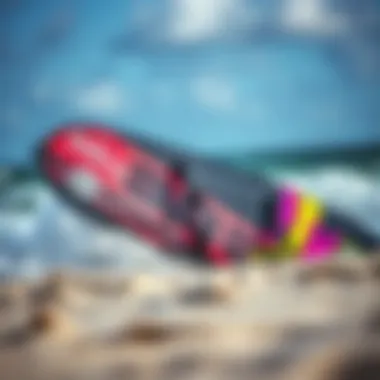
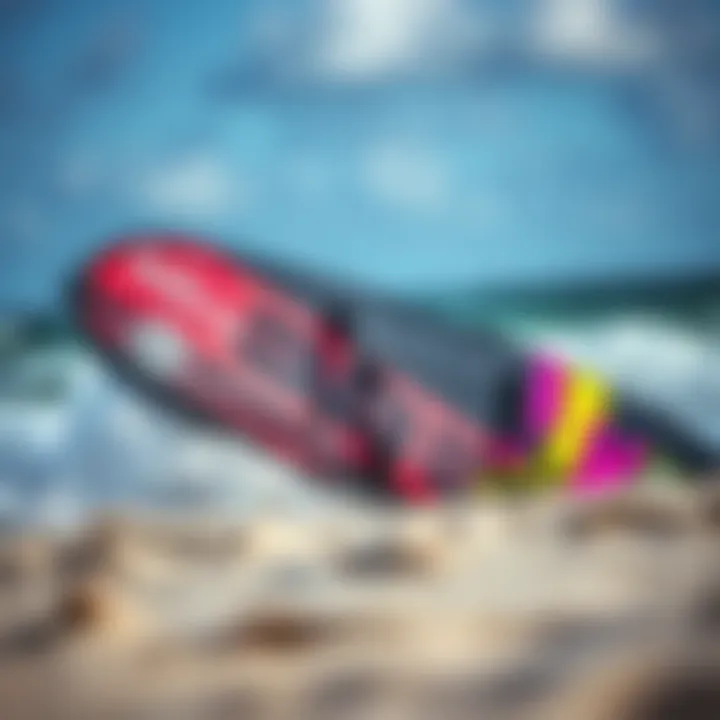
Intro
Choosing the right kiteboard bag is a crucial step for both budding and seasoned kiteboarders. This article is your go-to resource for navigating the myriad of options available on the market. With countless styles, sizes, and features to consider, having a clear understanding will not only protect your gear but also enhance your experience on the water. The right bag can mean the difference between a seamless trip and a frustrating ordeal.
Gear and Equipment
When it comes to kiteboarding, understanding the essential gear is key to getting started and mastering the sport. The kiteboard bag you choose should integrate well with your overall setup, providing space, protection, and ease of travel.
Essential Kiteboarding Gear for Beginners
For those just starting out, the essentials usually include a good kite, a board, a harness, and safety equipment like a helmet and impact vest. Adding a suitcase-style kiteboard bag to the mix can simplify transportation. These bags often come padded to shield your gear from rough handling. Each item of gear plays a role in your learning journey, and having a reliable bag enhances the accessibility and safety of transporting them.
- Kite: Choose one that matches your skill level and wind conditions.
- Board: Consider size and shape; it affects how you'll ride.
- Harness: Important for comfort and control.
- Safety Gear: This includes helmets and life jackets, crucial for a safe experience.
Well-built kiteboard bags can accommodate these items, ideally designed with ample padding and compartments. Look for features like rollable wheels and durable zippers that withstand the rigors of travel.
Advanced Equipment for Experienced Riders
As you progress, the equipment you use may require a different kind of transport solution. Advanced riders typically invest in specialized designs that cater to their unique preferences and extensive gear. When selecting a kiteboard bag at this level, think about:
- Material Quality: High-density fabric can withstand more wear and tear.
- Size Variability: Ensuring it fits boards of different lengths as skills advance.
- Weight Distribution: Opt for bags that balance well to make transport less cumbersome.
Many advanced bags also come with modular compartments for easy access to individual items, keeping everything organized. Having a bag that adapts to your gear as you grow in your kiteboarding journey helps maintain the longevity of your investments.
"A good kiteboard bag not only protects your gear but also makes your adventures smoother and more enjoyable."
The right choice of equipment, paired with an appropriate kiteboard bag, contributes significantly to a rewarding kiteboarding experience. As we move forward, we will tackle other facets that assist kiteboarders to get the most out of their gear and journey.
Preface to Kiteboard Bags
Every kiteboarder knows that having the right gear can make or break your day on the water. One of the most critical yet often underrated components of this gear is the kiteboard bag. This section introduces kiteboard bags, focusing on their importance and what to consider when selecting one. By understanding these factors, both new and seasoned kiteboarders can ensure their equipment is well-protected and easy to transport.
The Importance of Protective Gear
When you're passionately involved in kiteboarding, every piece of gear matters. A kiteboard bag is not just a storage solution; it is essential for protecting your investment. Kiteboards are mainly made of fragile materials like fiberglass and foam, which can easily get damaged if thrown around or knocked against hard surfaces.
- Protection from Impact: A good-quality bag acts as armor against any bumps and bruises that come with travel. Whether you're heading to the beach or flying overseas, it's crucial to have a bag that provides adequate cushioning.
- Weather Resistance: The elements are unforgiving. Water, sand, and sun can all wreak havoc. A durable bag made from weather-resistant materials can keep your equipment dry and clean.
- Convenience: With various options like shoulder straps and wheels, kiteboard bags make it easier to lug around your gear. No more juggling a board, a kite, and accessories while trying to keep everything intact.
In essence, a kiteboard bag is not merely a transport tool but a safeguard for your cherished equipment. Investing in a quality bag might save you heartache down the line should something unfortunate happen to your board.
Overview of the Kiteboarding Market
Understanding the kiteboarding market provides valuable context for prospective buyers navigating the sea of options available. The rise in popularity of kiteboarding—thanks to its mix of thrill and skill—has led to a burgeoning market that caters to enthusiasts at all levels.
- Growing Demand: As more people take to the waters, the demand for specialized gear, including kiteboard bags, has increased significantly. Manufacturers are expanding their offerings not only in terms of performance but also in protective gear.
- Diverse Options: Retailers today showcase a wide range of kiteboard bags, from soft-shell varieties to hard-shell cases. Each type offers distinct advantages based on individual preferences and usage situations.
- Brand Varieties: There's no shortage of brands eager to supply kiteboarders with the best equipment. This competition encourages innovation, so aspiring kiteboarders can find bags designed with unique features like specialized compartments or ergonomic designs.
The kiteboarding landscape continues to evolve, showcasing a robust market where quality meets innovation.
In summary, understanding both the protective elements of kiteboard bags and the kiteboarding market landscape is essential for making informed choices that enhance your experience on the water.
Types of Kiteboard Bags
When it comes to protecting your gear while traveling, understanding the various types of kiteboard bags is essential. Each type offers distinct benefits and features; thus, choosing the right one is pivotal for ensuring your kiteboarding equipment is both safeguarded and easily transportable. Frequent travelers will appreciate that specific bag designs cater to varying preferences, budgets, and travel styles. Let's delve into the three primary categories of kiteboard bags: soft shell, hard shell, and the distinctions between backpacks and wheeled bags.
Soft Shell Kiteboard Bags
Soft shell kiteboard bags are often the go-to choice for many kiteboarders, especially those who prioritize flexibility and lightweight options. These bags are typically constructed from durable fabric materials such as nylon or polyester, which lend them a degree of resilience against wear and tear. One of the advantages here is that they usually accommodate kites and boards of varying shapes and configurations, which is a boon for diverse setups.
Additionally, soft shell bags often come with ample padding, enhancing protection without the bulkiness that hard shell alternatives might present. This type of bag is particularly beneficial for kiteboarders who frequently travel by plane, as they can be maneuvered easily through crowded airports or packed into tight spaces. However, it’s worth noting that while they provide reasonable protection, they may lack the high-level impact resistance that hard shell bags are known for.
Hard Shell Kiteboard Bags
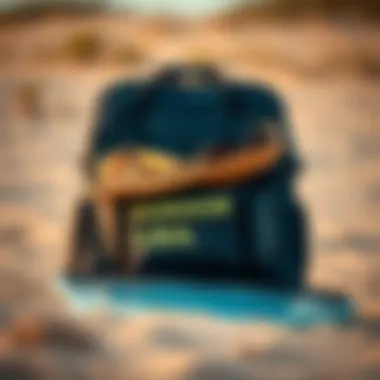
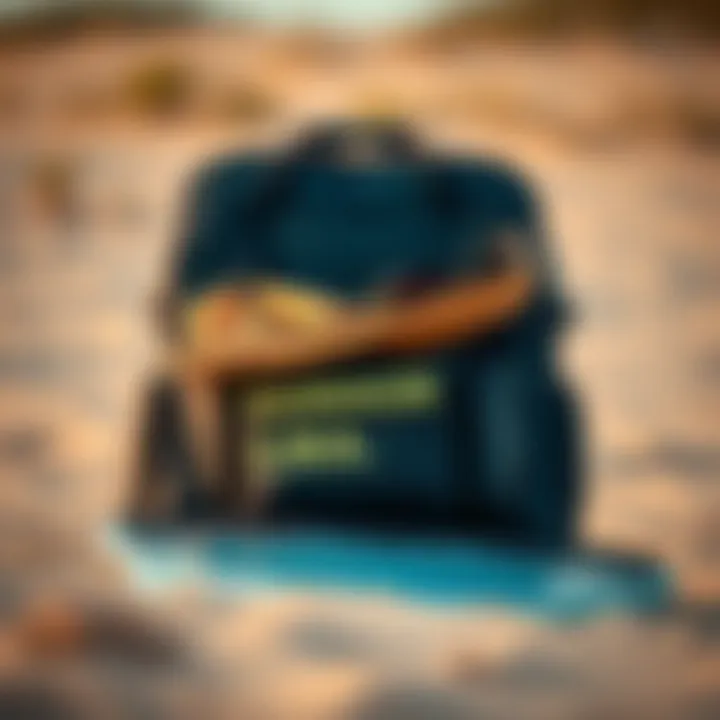
Switching gears, hard shell kiteboard bags present a more robust option, catering to those who prioritize maximum protection for their equipment. These bags are constructed from rigid materials, often incorporating molded plastic or composite materials designed to absorb impact. For kiteboarders who often find themselves navigating rough handling during air travel or car trips, hard shell bags can be worth the investment.
Moreover, many hard shell designs feature built-in wheels and a sturdy handle system, making them easier to transport despite their heavier weight compared to soft shell bags. An important consideration with hard shell bags, however, is their size and bulkiness. They may not fit as easily into smaller spaces, and storing them might also pose a challenge.
Backpacks vs. Wheeled Bags
When facing the choice between backpacks and wheeled bags, it boils down to personal preference and travel habits. Backpacks, for instance, offer a hands-free experience that can be a lifesaver when traversing uneven terrain or crowded environments. They typically feature ergonomic straps for comfort, which is crucial for long walks from parking lots to beaches. On the downside, they may not always provide as much protection for bulky gear. It’s advisable for users to pack strategically to prevent excessive strain on the back.
Wheeled bags, in contrast, shine in scenarios where smooth terrain is available. They relieve the burden on your shoulders and can carry heavier loads without causing fatigue. However, wheeled bags can prove cumbersome on sandy or rocky surfaces, where dragging a bag may become an uphill battle.
Ultimately, the choice between these two styles depends on individual travel patterns – whether you’re trekking across city streets or simply rolling to the beach. Both options have their pros and cons, and careful consideration will lead to the right choice for any kiteboarder.
Key Features to Consider
Choosing the right kiteboard bag is no small potatoes. With different types available in the market, it’s crucial to zero in on specific features that can make or break your experience. A bag that fits your needs can save you time, protect your gear, and even facilitate easier travel. So, let's dive into these features one by one to ensure you’re making an informed decision.
Size and Capacity
When it comes to kiteboard bags, size isn't just about how much the bag can hold. It’s also about ensuring that you can comfortably transport everything you need. Sizing should account for the kite itself, any boards, and additional gear like straps and harnesses. Too often, kiteboarders underestimate how much space they'll require.
If you're a frequent traveler, opting for a bag with adequate capacity can save you from those awkward moments at the airport where you’re cramming stuff in every nook and cranny. A good guideline is to choose a bag at least 10 centimeters longer than your longest board, ensuring you don’t end up damaging your equipment during transit. Remember, a bag that's too small will lead to a tight squeeze, making it harder to put your gear away and retrieve it when you need it.
Padding and Protection
We've all heard the phrase "better safe than sorry". This rings especially true when transporting delicate and expensive gear. Adequate padding is paramount in providing the necessary protection against shocks or drops during travel. Many high-quality bags come equipped with a layer of foam or thick padding around the sides—consider these features not just add-ons but essentials.
Acceptable padding can absorb impacts that might otherwise damage your board and kites. Look for bags that also have reinforced corners and edges. These areas are often the first to suffer wear and tear; they need to be robust enough to handle the rigors of travel.
Material Durability
In the world of kiteboarding, your bag doesn't just need to look good; it should withstand the elements. Durable materials are your best friends in ensuring longevity. Many bags are made from robust textiles like cordura or ballistic nylon, which resist tears and abrasions. Furthermore, waterproof materials are a significant plus as they can keep your equipment dry if caught in unexpected weather.
Over time, lower quality materials can degrade, leading to rips and holes that allow moisture in. You wouldn’t want to find your kite drenched after a rainy day. Studies show that opting for a higher-grade material can extend the life of your bag, making the initial investment worthwhile.
Carrying Options
Carrying a kiteboard bag shouldn’t feel like you’re lugging a boulder uphill. Various styles of carrying options can offer ease and convenience. Some bags come with padded shoulder straps, while others may have grab handles or even wheels for rolling. This is especially important if you’re navigating through busy airports or sandy beaches.
Think about your travel lifestyle. Do you prefer to walk longer distances, or will you try to stick to short trips? If you often find yourself needing to haul gear over a mile or more, a bag with comfortable, adjustable straps may be the way to go. Wheels are a great addition if you frequently catch flights or take long car rides.
By prioritizing these key features—size and capacity, padding and protection, material durability, and carrying options—you’ll be well on your way to selecting a kiteboard bag that aligns with your needs and elevates your kiteboarding experience. This careful consideration will not only enhance your adventures but also safeguard your valuable gear, ensuring that every trip is smooth sailing.
Brands to Explore
When navigating the vast ocean of kiteboard bags, knowing which brands stand out can save time, money, and frustration. The brand you choose can often tip the scales in favor of durability, functionality, and cost-effectiveness. As kiteboarding enthusiasts know, gear is not just an accessory but a vital component of the experience itself. The right bag not only protects your equipment but also reflects your personal style and needs.
Several established brands have carved a niche in the kiteboarding market, gaining reputation through perennial quality and innovative designs. Understanding their offerings helps consumers make informed choices based on factors like material, size, and special features. This section delves deeper into both the top players marking their territory in the industry as well as the promising newcomers who aim to shake things up. Let's take a closer look.
Top Industry Players
It's no secret that certain brands have achieved a strong foothold in the kiteboarding community. These companies are trusted by both amateurs and seasoned pros alike. Some key players include:
- Mystic: Known for their top-notch kiteboard bags, Mystic combines style with functionality, often featuring strong materials and innovative designs that stand up to the rigors of transport.
- Naish: With a reputation for high performance and durable gear, Naish offers an array of bags with smart compartments, ensuring every piece of gear has its place.
- Slingshot: This brand often wows consumers with products built to last, and their kiteboard bags come equipped with thoughtful features like padded compartments and compression straps.
- Dakine: A favorite amongst adventure seekers, Dakine excels in practicality with bags designed specifically for carrying kiteboards, offering a wide selection that caters to different preferences.
While these brands lead the pack, it's important to recognize that their success stems from understanding what users truly need - be it added padding for transport, versatility in carrying options, or simply aesthetic appeal. The loyalty they create around their products should not be understated, as many kiteboarders will swear by a specific brand.
Emerging Brands
Just because they’re newer doesn’t mean emerging brands lack potential. In fact, many of them are making significant waves by introducing fresh designs and innovative functionalities that cater needlessly under budget constraints and creative solutions.
For example, consider Ozone, a rising star in the realm of kitesurfing gear, which spans beyond just kites to also cover bag solutions with environmentally sustainable materials. Their vision for sustainability resonates with eco-conscious adventurers, proving that performance need not come at the expense of the planet.

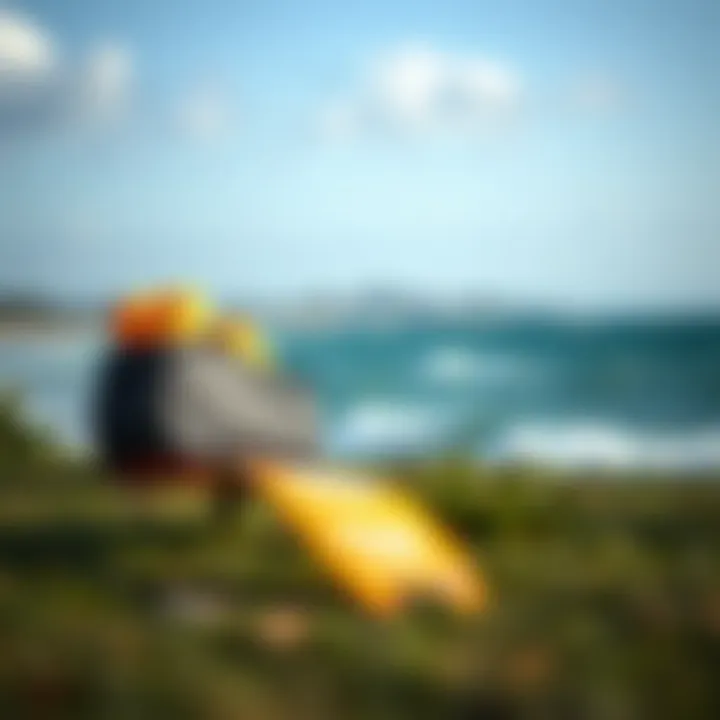
Another emerging name is F-one, which has been regularly surprising the market with striking bag designs that focus on detail and utility. Their bags often boast sleek aesthetics while maintaining great functionality, allowing riders to make a statement while keeping their gear safe.
Finally, there's ION, a brand that has aggressively entered the market with various accessories including bags, offering budget-friendly choices without compromising on quality and style. They appeal particularly to novice kiteboarders looking for reliability without breaking the bank.
These emerging brands signify that the kiteboarding spirit thrives on innovation, pushing the limits of what's possible in gear transport solutions.
Where to Buy Kiteboard Bags
Finding the right place to purchase your kiteboard bag is just as crucial as selecting the bag itself. With the abundance of options available, knowing where to shop can not only save you time but also ensure you get the best bang for your buck. Whether you're a seasoned rider or just starting out, understanding the various outlets—both online and brick-and-mortar—can alter your shopping experience profoundly.
In today's market, shoppers have a myriad of choices. Taking a closer look at where to buy kiteboard bags will shed light on the benefits and considerations of each option.
Online Retailers
The digital era has made online shopping incredibly convenient. With a few clicks of the mouse or taps on the screen, you can browse through hundreds of options without even leaving your home. When searching for kiteboard bags online, you might find various retailers that cater specifically to water sports enthusiasts, or larger e-commerce sites that have a broad selection.
Here are a few benefits to consider:
- Variety: Online retailers often boast huge inventories. You can find all types of bags—soft, hard, or wheeled—without the hassle of visiting multiple stores.
- Reviews and Ratings: Shoppers can read reviews from others who have purchased the same product, giving insights into durability and performance. Popular sites like Amazon or SurfStitch offer user feedback that can guide your decision-making.
- Price Comparisons: The ability to compare prices against multiple vendors at once can snag you a great deal. Websites like PriceGrabber or Google Shopping can help streamline this process.
However, there are downsides too:
- Lack of Inspection: Purchasing online means you can’t physically inspect the bag before buying, leaving potential issues unnoticed until it arrives in the mail.
- Shipping Costs: Always remember to check shipping fees, as these can unexpectedly inflate the overall cost of the bag.
Local Shops and Specialty Stores
If you prefer a hands-on shopping experience, local shops and specialty stores can provide invaluable benefits. Many kiteboarding shops not only sell gear but often offer advice from seasoned professionals. This personal approach can enhance your understanding of what bag best suits your needs.
Some advantages of shopping locally include:
- Expert Guidance: Staff at specialty stores are often knowledgeable and passionate about kiteboarding. They can provide tailored recommendations based on your specific requirements, like travel frequency or type of kiteboarding you're interested in.
- Try Before You Buy: You can physically see and feel the bags. This can be a significant advantage in assessing the quality and fit, especially in terms of size and padding.
- Support Local Business: By shopping at local stores, you're contributing to your community. It’s a win-win situation that supports local entrepreneurs while fulfilling your gear needs.
On the other hand, there are a few considerations:
- Limited Selection: Local shops may not carry the extensive range that online retailers do. If you're looking for something specific, this could be a drawback.
- Pricing: Sometimes, local shops might have a slightly elevated price point due to lower volume sales compared to large online retailers.
"It's not just about buying a bag; it’s about finding the right bag that matches your kiteboarding aspirations."
For more about kiteboarding tips and tricks, check out resources at the Kiteboarding Association kiteboardassociation.org.
Price Range and Budgeting
Understanding price range and budgeting is crucial when choosing a kiteboard bag. It not only provides a context within which you’ll operate but also helps to refine your options based on what you can afford while still staying true to quality. Kiteboarding gear, including bags, can vary widely in pricing, influenced by several factors like durability, brand reputation, and specific features.
When you’re prowling through the options, keep in mind that the cheapest option isn’t always the best choice. You need to ask yourself what you really need from your bag. Do you often travel long distances? Maybe a hard shell bag is worth the investment for its added protection and durability. But if your needs are minimal, a more affordable soft shell might suit you just as well.
Understanding Price Variability
The price of kiteboard bags can differ for a multitude of reasons.
- Material Quality: Higher-quality materials, like reinforced nylon or tarpaulin, often come at a premium compared to basic polyester. Materials impact not just price but the longevity of the bag as well.
- Brand Reputation: Well-known brands like Naish, Duotone, and Mystic typically command higher prices because of their proven track record. Conversely, emerging brands might offer competitive pricing while still providing decent quality.
- Features and Design: Bags equipped with wheels, multiple compartments, and extra padding will usually cost more. These features, although pricier, can enhance convenience and security when traveling.
Understanding these factors helps kiteboarders closely examine how much they’re willing to spend and what trade-offs they might need to make.
Finding Deals and Discounts
Finding the right kiteboard bag at an affordable price doesn’t have to be a Herculean task. There are practical ways to snag a good deal:
- Seasonal Sales: Pay attention to holiday sales, such as Black Friday or end-of-season promotions, when many retailers offer significant discounts.
- Online Marketplaces: Websites like Amazon, eBay, and specialized kiteboarding retailers often have customer reviews highlighting previous sales or exclusive deals. Always check user feedback for reassurance.
- Local Shops: Occasionally, local surf or kite shops have inventory sales. If you’ve got a favorite store in the area, swing by to see if they’re offloading last season's styles to make room for new stock.
- Social Media and Forums: Keep an eye on kiteboarding forums or communities on platforms like Reddit and Facebook. Members often share discount codes or links to sales that may fly under the radar.
"Investing time in researching price and budgeting can save you a considerable amount while ensuring you get maximum value for your kiteboarding adventures."
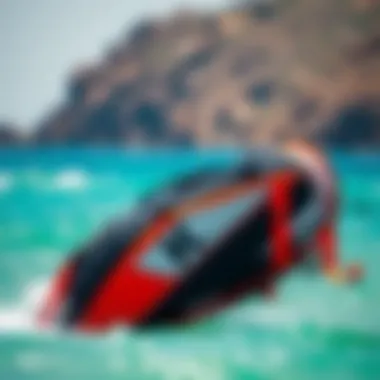
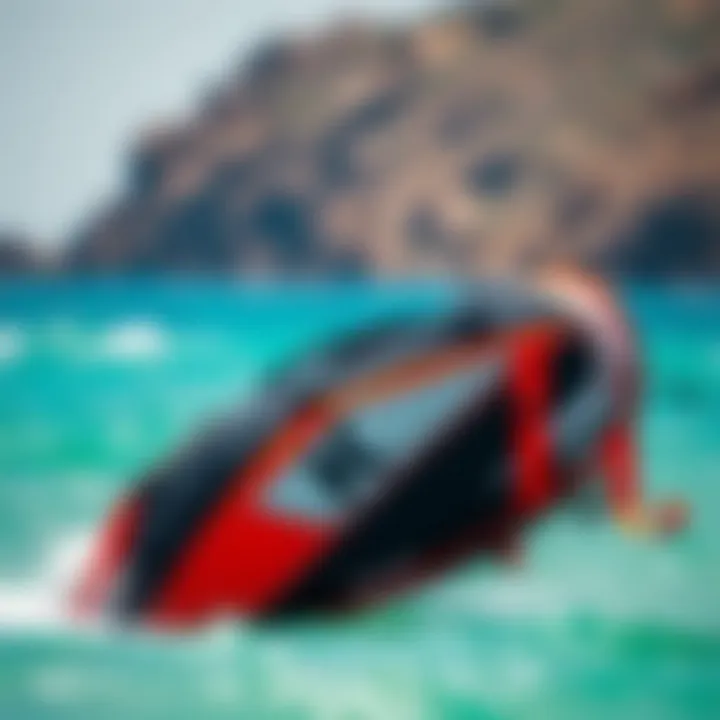
Being mindful of the price range and making informed budget decisions is a game-changer. It ensures that you find a kiteboard bag that meets your needs without putting your finances at risk. That balances quality, features, and price should be your guiding principle in the purchasing process.
Care and Maintenance of Kiteboard Bags
Kiteboard bags endure quite a bit in their lifetime, and taking care of them is crucial not just for longevity but also for keeping your gear in top-notch condition. Without proper maintenance, even the best bags can succumb to wear and tear, leading to potential damage to your precious boards and kites. It’s like owning a high-performing sports car; even the best engine needs regular upkeep.
Regular care ensures your bag remains functional, tidy, and ultimately, prolongs its life. Through the right cleaning techniques and storage advice, you can avoid common pitfalls that many kiteboarders face, thus safeguarding your investment.
Cleaning Tips
Maintaining the cleanliness of your kiteboard bag is essential, especially if you often find yourself in sandy or muddy locations. Regular cleaning can prevent dirt build-up, which might otherwise wear down the material over time. Here are some handy tips to help you keep your bag spick and span:
- Gentle Wash: Use a mild soap and warm water solution. Harsh chemicals can degrade the bag’s material, making it vulnerable.
- Soft Brush or Cloth: Opt for a soft-bristle brush or a cloth to gently scrub away grime. Pay special attention to zippers and corners where dirt accumulates.
- Air Dry: After washing, let the bag air dry in the shade. Avoid direct sunlight; it can lead to fading and weaken materials.
- Inspect After Each Use: Look for any signs of damage or wear after use. Address any issues immediately to prevent them from escalating.
Remember, a little TLC goes a long way in ensuring your gear remains safe and sound.
Storage Recommendations
When it comes to storing your kiteboard bags, how you do it can significantly affect their lifespan. A few considerations can make all the difference:
- Cool, Dry Place: Store your bag away from direct sunlight and moisture, which can compromise the fabric’s integrity and lead to mold or mildew formation.
- Empty It Out: Always clean out your bag after use. Leaving gear inside can create unnecessary stress on the bag’s fabric and zippers.
- Avoid Overstuffing: While it may be tempting to shove in as much as possible, this can warp the shape of the bag and damage it over time.
- Use a Cover: If possible, protect your bag with a breathable cover during storage. This helps to keep dust and debris at bay.
- Hang or Lay Flat: Store the bag in a position that keeps pressure off its seams and zippers.
Taking the time to properly maintain and store your kiteboard bag helps ensure that your gear remains not just ready for your next adventure but also retains its value over the years.
Common Mistakes to Avoid
When it comes to choosing the right kiteboard bag, many individuals tend to stumble upon common pitfalls that can greatly affect their purchasing decision. Understanding these mistakes can save time and ensure that your gear is properly cared for. Let's explore the notable areas that kiteboarders, both novice and seasoned, often overlook.
Underestimating Size Needs
One of the significant blunders many kiteboarders make is underestimating the size of the bag they need. It might seem tempting to settle for a bag that’s just right, but considering future gear and optimal space is crucial. If your plans include upgrading your kiteboard or adding extra equipment for those spontaneous trips, seeking a larger bag might be wise.
- What to Think About:
- Consider the number of boards, kites, and additional items like harnesses or wetsuits you plan to carry.
- Take note of any travel regulations, especially when considering air travel where luggage specifications can vary.
Buying a bag that’s too small not only risks damage to your gear but may also lead to inconvenient packing issues. It’s a far better move to invest in a slightly larger bag now than having to buy another one later because your original just doesn’t cut it.
Ignoring Material Quality
Another common misstep is opting for bags without taking into account the material quality. Kiteboard bags are exposed to a myriad of environmental conditions, from salty ocean air to sudden rain. Choosing bags made from inferior materials can lead to quick deterioration and provide little assurance to the safety of your gear.
- Why Material Matters:
- Durability: High-quality materials like ballistic nylon or Cordura resist wear and tear and stand up to rough handling.
- Weather Resistance: Bags that use waterproof or water-resistant materials keep your gear dry during unexpected downpours.
When you turn a blind eye to material quality, you might find that your bag frays or tears easily, leading to costly repairs or replacements. Instead, choosing a durable bag can ensure your kiteboarding gear remains protected, even in less-than-ideal conditions.
"Choosing the right kiteboard bag can mean the difference between enjoying your adventure and facing unnecessary headaches."
By understanding these common mistakes, you can make more informed choices that align with your needs. Your kiteboarding experience should be about the thrill of the ride—not the hassle of faulty gear storage.
Finale and Final Thoughts
Navigating through the maze of kiteboard bags can be a daunting task, but it's an investment well worth making. As we've explored in this article, understanding your individual needs is crucial when selecting the right bag. Kiteboard bags are not just carriers; they're vital for the protection and longevity of your gear. A well-chosen bag can mean the difference between damaged equipment and a smooth sailing experience.
Summarizing Key Points
To wrap things up, several key elements stand out regarding kiteboard bags. First, consider the type that fits your style—be it soft shell for flexibility or hard shell for maximum protection. Size and capacity matter too; a bag too big can be unwieldy, while one too small might leave your gear crammed and vulnerable. The quality of materials used plays a critical role; a flimsy fabric could tear at the worst possible time. Lastly, evaluate the carrying options available. Wheels might ease transport in urban settings, but sturdy shoulder straps can be lifesavers on rugged terrain.
These points serve not just as checkboxes but as guiding principles in your selection process.
Encouragement for Informed Decisions
In this fast-paced world of kiteboarding, making informed decisions should be at the forefront of your mind. Prioritize quality over cost; what might seem like a bargain today could turn into a regrettable decision later. Research different brands, read reviews, and tap into forums like Reddit or knowledge pools on educational sites to collect diverse opinions. Your gear deserves only the best, and investing in a reliable kiteboard bag enhances your overall kiteboarding experience.
Remember, a well-protected kiteboard is a key ingredient for enjoying those adrenaline-packed days on the water. Don't let negligence spoil your fun.
As you venture forward, keep these insights in your back pocket. Equip yourself with the right information, and you’ll not only safeguard your gear but also ensure a more satisfying kiteboarding experience for years to come. Happy riding!



